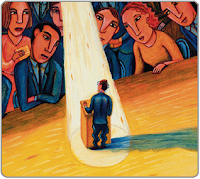

In order to deliver a successful speech, the speaker must first overcome the fear of speaking in public, which is also known as “glossophobia” or stage fright. It is important to control the fear, because when an audience sense that the speaker is in fear, they tend to shut the speaker out for that reason alone. The fear can be detected by the listeners in many ways, many of which are from the movements of the speakers. Some examples of of these movements include :

· Shuffling from foot to foot
· Wild or random gestures with the hands
· Stuttering and jumbling of words
· Speaking too fast
· No eye contact with the audience
· Referring to written notes too often
· Clearing throat repeatedly
To overcome these symptoms, the best way is by practice. Frequent practice will raise one’s confidence level. One must not be afraid to do a mistake, because we learn through mistakes. Try practice speaking in front of a mirror or in front of close relatives to test the pitch and volume of one’s voice. The pitch cannot be too high because it might irritate the listeners, and a slow voice will lead the audience to sleep. Practice also lets you speak more fluently when the real time comes for the speech. This is important because the listeners need to really understand what you are saying in order to get the message.

During the speech, try adding some humour or jokes to keep the audience entertained and prevent them from getting bored. Laughing can make a sleepy person stay wide awake for the whole section of a speech. Orators who use humour in their speech are more effective compared to those who give serious speeches.

Besides that, try building a relationship with the audience at the start of the speech. The bond created can keep the audience focussed on the orator and the topic he or she is talking about. These bonds can be created by asking questions at the audience such as “how are you today?”. When someone answers a question, ask for their name. Doing this can make the audience feel that the speaker is interested in them, and will therefore keep the audience paying attention.

The most important thing when giving a speech is to be yourself. The speech given does not to be perfect, just good and entertaining for the audience. One cannot deliver an information or message well if they feel awkward. However, the best way is to prepare before a speech and practice a lot.







